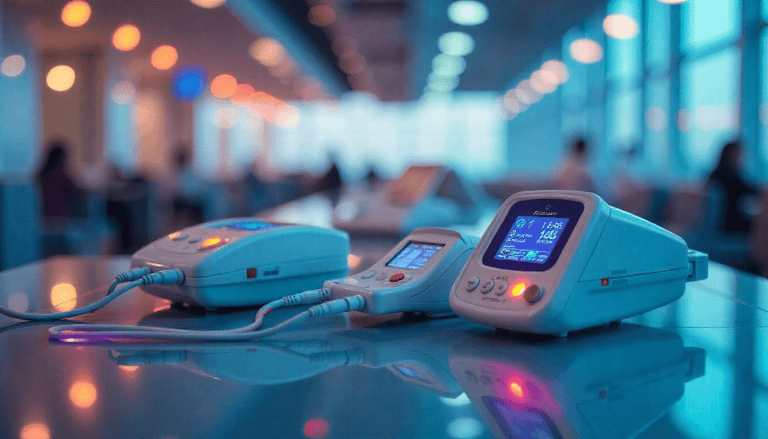TSA Rules for Flying with Hearing Aids and Cochlear Implants

Flying can be chaotic enough—tight connections, gate changes, blaring announcements—but when you rely on a hearing aid or cochlear implant, the challenges multiply. Can you wear it through security? Will it interfere with the plane’s electronics? What if you miss a boarding call?
If these questions sound familiar, you’re not alone. I’ve spoken with travelers who’ve had their processors swabbed unexpectedly, missed overhead announcements at crowded gates, or struggled with recharging issues abroad.
This guide walks you through how to fly with hearing aids and what exactly what to expect, whether you’re flying across the U.S. or navigating customs internationally—from TSA procedures to real tips on making air travel smoother and more predictable.
If you’re looking for broader advice, check out my Flying with Medical Devices guide. But if your focus is hearing aids or cochlear implants, you’re in the right place.
Let’s break it all down so you can fly confidently and focus on your trip—not your device.
At The Keen Insider, we do the legwork so you can travel with medical devices prepared, informed, and worry-free. We monitor the latest TSA guidelines, customs rules, and airline requirements—and confirm with our team of experts in the field to ensure every guide reflects the most current policies.
1. How to Fly with Hearing Aids Domestically
1.1 Do You Need to Remove Hearing Devices at TSA Security?
No. You can walk through both standard metal detectors and millimeter wave scanners with your hearing aid or implant in place. However, TSA recommends you inform the agent if you are deaf or hard of hearing and require assistance with the screening process.
That said, if you’re pulled aside for additional screening, don’t be alarmed. TSA officers may want to:
- Visually inspect the device
- Swab it for traces of explosives
- Ask a few questions if they’re unfamiliar with it
Most agents are trained to recognize hearing devices, but not all are equally experienced.
KEEN TIP: Why tell the TSA officer before screening: “I wear a cochlear implant (or hearing aid) and may not hear you clearly?” It helps with communication but also signals that you may need a slower pace or clearer instructions.

1.2 Will the Scanner Damage My Device?
No, airport scanners won’t damage your device. Cochlear implants and hearing aids are built to withstand everyday exposure to electronic fields, including those used in airport security.
However, it’s important not to place sensitive external parts—like a processor or battery—directly on the X-ray belt. If TSA requests additional screening, ask for a manual swab instead of sending it through the machine.
Real-Life Example:
Recently, a traveler placed her hearing aid on the belt in a rush, only to find it slightly demagnetized on arrival. It’s a good reminder to be cautious and request that your medical device be screened separately.
KEEN TIP: If you must remove part of your device, place it in a clean, soft pouch and hand it directly to the agent for swabbing. Never set it in a bin with coins, keys, or liquids.
2. Communicating with Airport and Airline Staff
2.1 What If You Can’t Hear Announcements?
Let’s be honest—airports are noisy, and PA systems are often muffled or too fast. If you struggle to hear clearly, even with your device, don’t rely on announcements alone.
Here’s what helps:
- Notify the gate agent that you use a hearing device. Politely ask to be notified in person if there are last-minute changes.
- Use the airline’s mobile app. Many now offer push alerts for gate changes, delays, and boarding updates.
- Stay close to the gate area during boarding windows so you don’t miss visual cues.
KEEN TIP: If your phone has accessibility features (like Live Transcribe on Android or Sound Recognition on iPhone), turn them on during your airport time. They can pick up and convert announcements to text in real-time.

2.2 Can I Request Assistance?
Absolutely—and you should if you have concerns. The Air Carrier Access Act (U.S.) ensures your right to request support, and most international airports offer similar services.
You can ask for:
- Pre-boarding privileges, so you can get settled before the crowd rushes in
- Text-based flight updates or printed boarding passes
- One-on-one communication if paging is not effective
Just ask at the check-in counter or gate.
KEEN TIP: Call TSA Cares at 855-787-2227 at least 72 hours before your flight to arrange a Passenger Support Specialist. They can meet you curbside or at the checkpoint to guide you through screening and boarding.
3. Flying with a Cochlear Implant or Hearing Aid Onboard
3.1 Can You Wear Your Device During Takeoff and Landing?
Yes. Cochlear implants and hearing aids are safe to wear throughout the entire flight. They do not interfere with the aircraft’s electronics and are not considered transmitting devices like cell phones or Bluetooth headphones.
If your device connects via Bluetooth, you may be asked to turn off wireless features during takeoff and landing, depending on the airline’s policy.
KEEN TIP: If your hearing device uses Bluetooth, switch it to airplane mode or turn off connectivity during takeoff if instructed.
3.2 How to Handle Noise and Cabin Pressure
Airplane cabins can get noisy, which may interfere with sound quality. Cochlear implant users might notice changes in clarity or volume due to air pressure or cabin noise.
Helpful strategies:
- Use a personal loop system or remote microphone to hear announcements.
- Adjust sensitivity settings on your device if your model allows it.
- Bring extra batteries, especially for long-haul flights where recharging may not be possible.
KEEN TIP: Bring a hard case with backup batteries, cleaning tools, and a spare processor (if you have one) in your carry-on. Checked bags get lost—keep essentials with you.
4. International Travel with a Hearing Device
4.1 Do You Need to Declare a Cochlear Implant or Hearing Aid at Customs?
Typically, no. Hearing aids and cochlear implants are personal medical devices and do not need to be declared when entering most countries. However, some customs agents may ask questions if they’re unfamiliar with the device.
Bring a doctor’s letter or a device ID card to help explain what the device is and why you have it. We offer a free template for a doctor’s letter which your doctor can use to create your letter in our article: Simplify Air Travel with Meds: Free Doctor’s Letter Template.

KEEN TIP: If traveling internationally, print out a card or short statement in the destination language explaining what your device is. It can smooth over any confusion at customs or security.
4.2 Voltage and Charging Abroad
If your device uses rechargeable batteries or charging accessories, make sure you bring:
- A travel adapter for the destination country
- A voltage converter if your charger isn’t dual-voltage
- Backup disposable batteries if your device supports them
KEEN TIP: Check the voltage rating on your charger before you leave. Many modern hearing aid chargers are dual-voltage (100–240V), but it’s always best to double-check.
5. Flying with Children Who Use Cochlear Implants or Hearing Aids
If you’re flying with a child who uses a hearing device, the rules are the same—but the logistics can be a bit trickier.
Tips to make the trip easier:
- Have their doctor write a travel note in case questions come up.
- Pack extra batteries and spare parts in your carry-on.
- Use noise-canceling headphones or ear muffs for sensory support during takeoff.
KEEN TIP: Bring a small, labeled travel pouch with all of your child’s device gear: spare batteries, drying kit, backup processor, and doctor’s note. It helps you stay organized and speeds up screening if needed.
6. Frequently Asked Questions (FAQ’s)
6.1 Can I wear my hearing aid or cochlear implant through airport security?
Yes. You can wear them through metal detectors and body scanners. You don’t need to remove them unless instructed, and even then, you can ask for a hand inspection.
6.2 Will my device set off airport alarms?
It might. Cochlear implants or some hearing aids with metal parts may set off detectors, but this is normal. Let security know ahead of time to avoid confusion.
6.3 Can I bring extra batteries in my carry-on?
Yes. TSA and most airlines allow you to bring batteries for medical devices. Lithium batteries must go in your carry-on, not your checked bag.
6.4 What should I do if I miss an overhead announcement?
Let the gate agent and flight attendants know you have hearing loss. Ask them to alert you directly to any gate changes or instructions. You can also rely on airline apps for alerts.
6.5 Do I need to declare my device when traveling internationally?
In most cases, no. But carrying a doctor’s note or device ID card can help in case customs agents ask questions.
7. Wrap Up
Flying with a cochlear implant or hearing aid is easier than you might think. With a bit of planning—knowing TSA and airline rules, communicating with staff, and keeping your essentials close—you can travel confidently and comfortably.
Before every flight, run through a quick checklist: batteries charged, backup gear packed, app notifications turned on, and TSA Cares number saved in your phone. It’s five minutes that can save you a major headache.
KEEN TIP: Print a one-page travel sheet with your device info, doctor’s contact, and any translations needed for customs. It’s a small thing that can prevent a big delay.
Here’s to safe skies and clear conversations—no matter where you’re headed!






